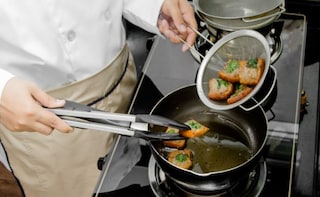Go beyond shallow frying
1. ShockingIt is a technique where the cooked food is quickly immersed in icy cool water or is placed under cool running water to halt the cooking process. Noodles or pasta is 'shocked' in ice-cold water post boiling to avoid it being overcooked.2. Brining versus PoachingBrining is a popular technique which helps in preserving meats and fish. It involves adding meat to a solution of water and salt. On the other hand, poaching involves submerging food items in flavoured liquid which can range from milk, stock, wine or water. Brining essentially, improves the texture of a food item and helps in preservation; poaching is more of a flavouring technique.
3. FlambéIt is a technique in which foods are topped with alcohol and literally set on fire. The process leaves behind a subtle taste of alcohol lingering in the food and a certain smokiness. Once set on fire, the dish exhibits blue flames rising from it which makes for quite a show. Generally, liquours like rum, brandy or cognac are used to flambé foods over beer, wine or champagne.4. DredgingIt It is a cooking technique used to give your food a crispy coating. In this process, foods are coated with flour, breadcrumbs or any other dry or wet material. Fish fillets, boneless poultry, pork cutlets, and veal cutlets are some of the foods that are often dredged in flour and other dry ingredients before cooking.5. CoddlingIn culinary terms, coddling means cooking food in water below the boiling point. In recent times this term is only used for coddling eggs. Process of coddling usually takes longer than usual because eggs are prepared at a lower temperature. In this process, usually the egg is cracked in a small buttered dish, along with seasonings and then is partially immersed in a hot water for several minutes. This process produces tender eggs.6. CharbroilingIt is a process of cooking or grilling meat at a very high temperature on a grated surface to enhance the flavors. This process also gives the food a light charcoal smoke flavor.7. Teriyaki cookingJapanese cooking method in which the foods are cooked by radiant heat or simply grilled with a coat of soy sauce, mirin and sugar. Teriyaki where 'Teri' refers to the shine and luster which is given by brushing the sauce on the food whereas 'Yaki' refers to the cooking method that is broiling or grilling.8. SweatingSweating is a technique of cooking food over low heat using very less fat, generally in a covered pan. It is often done with vegetables in order to soften and cook them their own juices without browning. Sweating basically blends the flavors well.9. Marinating versus TenderizingMarinating is really important. It ensures that the meat pieces are loaded with juices, oils, flavours and aroma of the marinade making pieces nice and fluffy; moist and juicy. Tenderizing is a similar process but aims at making meat softer and tender, it doesn't aid in enhancing the flavour of your preparation.You can choose just about any flavouring agent in your marinade, from herbs, varied spices, curd to oil, vinegar and much more. Tenderizing is done with agents that will moisten and soften the pieces. This is undertaken with the help of ingredients like vinegar, curd, wine, lemon juice, buttermilk and papaya.Take note that a marinade works as a flavouring technique whereas tenderizing renders the meat softer and tender texture.
10. BlanchingA technique that's usually reserved for vegetables, blanching is when the main ingredient is dunked into boiling water for a few minutes/ seconds and then put in ice cold water or under running tap water.11. BraisingA cooking technique that gives you tender, fall-off-the-bone meat every time. The main ingredient is seared in fat and then simmered in a crock pot or pressure cooker full of liquid.12. SearingThis technique is used primarily to render food a distinct burnt, caramelized crust and flavour. To achieve this, the item (meat or fish) is cooked at high temperature until the surface starts caramelizing.There you go, try each one of them every day and share with us your culinary experiences below in the comment box.
Advertisement
1. ShockingIt is a technique where the cooked food is quickly immersed in icy cool water or is placed under cool running water to halt the cooking process. Noodles or pasta is 'shocked' in ice-cold water post boiling to avoid it being overcooked.2. Brining versus Poaching
Advertisement
3. FlambéIt is a technique in which foods are topped with alcohol and literally set on fire. The process leaves behind a subtle taste of alcohol lingering in the food and a certain smokiness. Once set on fire, the dish exhibits blue flames rising from it which makes for quite a show. Generally, liquours like rum, brandy or cognac are used to flambé foods over beer, wine or champagne.4. Dredging
Advertisement
Advertisement
10. BlanchingA technique that's usually reserved for vegetables, blanching is when the main ingredient is dunked into boiling water for a few minutes/ seconds and then put in ice cold water or under running tap water.11. BraisingA cooking technique that gives you tender, fall-off-the-bone meat every time. The main ingredient is seared in fat and then simmered in a crock pot or pressure cooker full of liquid.12. SearingThis technique is used primarily to render food a distinct burnt, caramelized crust and flavour. To achieve this, the item (meat or fish) is cooked at high temperature until the surface starts caramelizing.There you go, try each one of them every day and share with us your culinary experiences below in the comment box.
For the latest food news, health tips and recipes, like us on Facebook or follow us on Twitter and YouTube.
Advertisement
